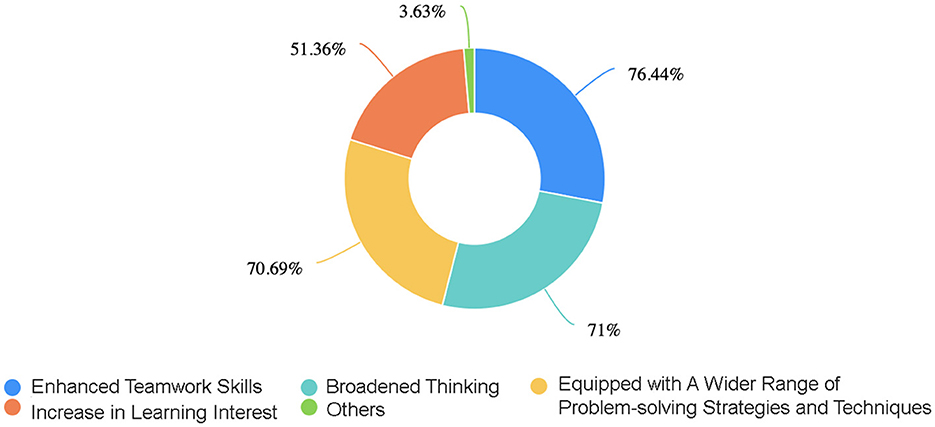- 1Department of Histology and Embryology, School of Basic Medical Sciences, Fujian Medical University, Fuzhou, Fujian, China
- 2Key Laboratory of Stem Cell Engineering and Regenerative Medicine of Fujian Province University, School of Basic Medical Sciences, Fujian Medical University, Fuzhou, Fujian, China
A Correction on
The effect of PBL teaching method in the teaching of congenital malformation
by Li, H., Cai, Z., Liu, Y., Chen, Y., Lin, Q., and Liu, H. (2025). Front. Med. 12:1508415. doi: 10.3389/fmed.2025.1508415
In the published article, there was an error in Figure 4 as published. The error pertains specifically to the percentage values displayed in the figure. The corrected Figure 4 and its caption “The ring chart presents a distribution of the percentages of the various positive impacts for students after adopting the PBL teaching method. These data outline the percentages of “Enhanced Teamwork Skills,” “Broadened Thinking,” “Equipped with A Wider Range of Problem-solving Strategies and Techniques,” and “Increase in Learning Interest”.” appear below.

Figure 4. The ring chart presents a distribution of the percentages of the various positive impacts for students after adopting the PBL teaching method. These data outline the percentages of “Enhanced Teamwork Skills,” “Broadened Thinking,” “Equipped with A Wider Range of Problem-solving Strategies and Techniques,” and “Increase in Learning Interest”.
The original article has been updated.
Publisher's note
All claims expressed in this article are solely those of the authors and do not necessarily represent those of their affiliated organizations, or those of the publisher, the editors and the reviewers. Any product that may be evaluated in this article, or claim that may be made by its manufacturer, is not guaranteed or endorsed by the publisher.
Keywords: PBL teaching method, traditional teaching methods, congenital malformation, questionnaire survey, evaluation
Citation: Li H, Cai Z, Liu Y, Chen Y, Lin Q and Liu H (2025) Correction: The effect of PBL teaching method in the teaching of congenital malformation. Front. Med. 12:1649453. doi: 10.3389/fmed.2025.1649453
Received: 18 June 2025; Accepted: 16 July 2025;
Published: 29 July 2025.
Edited and reviewed by: Lynn Valerie Monrouxe, The University of Sydney, Australia
Copyright © 2025 Li, Cai, Liu, Chen, Lin and Liu. This is an open-access article distributed under the terms of the Creative Commons Attribution License (CC BY). The use, distribution or reproduction in other forums is permitted, provided the original author(s) and the copyright owner(s) are credited and that the original publication in this journal is cited, in accordance with accepted academic practice. No use, distribution or reproduction is permitted which does not comply with these terms.
*Correspondence: Hui Liu, bGhsaGxoOTg5N0AxMjYuY29t
 Hua Li
Hua Li Zejun Cai1
Zejun Cai1